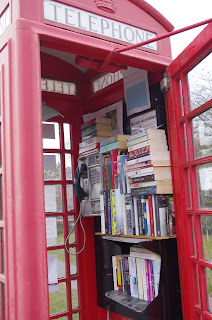Sunday, 7 April 2013
birthplace od scottish flag - athelstaneford
http://athelstaneford.wordpress.com/book-nook/
The St Andrew's Cross or Saltire is Scotland's national flag. Tradition has it that the flag, the white saltire on a blue background, the oldest flag in Europe and the Commonwealth, originated in a battle fought in East Lothian in the Dark Ages.
It is believed that the battle took place in the year 832AD. An army of Picts under Angus mac Fergus, High King of Alba, and aided by a contingent of Scots led by Eochaidh (Kenneth mac Alpin's grandfather) had been on a punitive raid into Lothian (then and for long afterwards Northumbrian territory), and were being pursued by a larger force of Angles and Saxons under one Athelstan.
The Albannach/Scots were caught and stood to face their pursuers in the area of Markle, near East Linton. This is to the north of the modern village of Athelstaneford (which was resited on higher ground in the 18th century), where the Peffer, which flows into the Firth of Forth at Aberlady, forms a wide vale. Being then wholly undrained, the Peffer presented a major obstacle to crossing, and the two armies came together at the ford near the present day farm of Prora (one of the field names there is still the Bloody Lands).
Fearing the outcome of the encounter, King Angus led prayers for deliverance, and was rewarded by seeing a cloud formation of a white saltire (the diagonal cross on which St Andrew had been martyred) against a blue sky. The king vowed that if, with the saint's help, he gained the victory, then Andrew would thereafter be the patron saint of Scotland. The Scots did win, and the Saltire became the flag of Scotland.
When Kenneth mac Alpin, who may have been present with his grandfather at the battle, later united Picts and Scots and named the entity Scotland, Andrew did indeed become the patron saint of the united realm. Kenneth mac Alpin, King of Scots and Picts, Ard-righ Albainn, was laid to rest on Iona in 860AD.
http://www.scottishflagtrust.com/legend.htm
Glenkinchie Distillery - Always a pleasure
The home of 'The Edinburgh Malt' is located in the rolling farmland of East Lothian and houses an excellent exhibition in the listed red brick buildings.
Few parts of Scotland can boast of more history than this. In 1745 Prince Charles Edward Stuart reached the peak of his brief power at Prestonpans on the Firth of Forth just north of Glenkinchie, where his Highlanders defeated John Cope's Hanoverian forces with such certainty that London itself seemed under threat.
The contemporary folk song 'Johnny Cope' records Cope's shocking defeat and his reaction after fleeing back to Dunbar, leaving his men.
Distilling (mostly illegal) was taking place here long before the skills of crop rotation were know; in 1777 Edinburgh housed perhaps four hundred illicit distilleries. When the law was changed to permit smaller licensed distilleries, many farmers took out licenses. Glenkinchie distillery is a Scotch single malt whisky distillery in East Lothian, Scotland. It is one of the six distilleries in the Lowland region. Glenkinchie lies, as the name might suggest, in a glen of the Kinchie Burn near the village of Pencaitland, East Lothian. It is situated about 15 miles from Edinburgh. The distillery is set in farmland. The name 'Kinchie' is a corruption of 'De Quincy', the original owners of the land. Its origins date back to around 1825 when it was founded by brothers John and George Rate. The original name was Milton Distillery. The brothers probably renamed it in about 1837. In 1969 the distillery stopped malting its own grain and the malting floors were turned into a museum of malt whisky.
The contemporary folk song 'Johnny Cope' records Cope's shocking defeat and his reaction after fleeing back to Dunbar, leaving his men.
Distilling (mostly illegal) was taking place here long before the skills of crop rotation were know; in 1777 Edinburgh housed perhaps four hundred illicit distilleries. When the law was changed to permit smaller licensed distilleries, many farmers took out licenses. Glenkinchie distillery is a Scotch single malt whisky distillery in East Lothian, Scotland. It is one of the six distilleries in the Lowland region. Glenkinchie lies, as the name might suggest, in a glen of the Kinchie Burn near the village of Pencaitland, East Lothian. It is situated about 15 miles from Edinburgh. The distillery is set in farmland. The name 'Kinchie' is a corruption of 'De Quincy', the original owners of the land. Its origins date back to around 1825 when it was founded by brothers John and George Rate. The original name was Milton Distillery. The brothers probably renamed it in about 1837. In 1969 the distillery stopped malting its own grain and the malting floors were turned into a museum of malt whisky.
The Glenkinchie label was relatively little known until 1989, when United Distillers started marketing it under their Classic Malts brand.The standard 10 year old Glenkinchie has now been replaced by the standard "12 year old". This is a fairly typical lowland whisky in that it is fresh and light in character, with notes of lemon and cut grass. It has a sweet nose and a hint of peat.
The 14 year old Distiller's Edition is double-matured in Amontillado sherry casks. The sherry flavour competes slightly with the freshness but does not overpower it.
http://en.wikipedia.org/wiki/Glenkinchie_distillery & http://www.discovering-distilleries.com/glenkinchie/malts.php
Subscribe to:
Comments (Atom)


















































.JPG)

